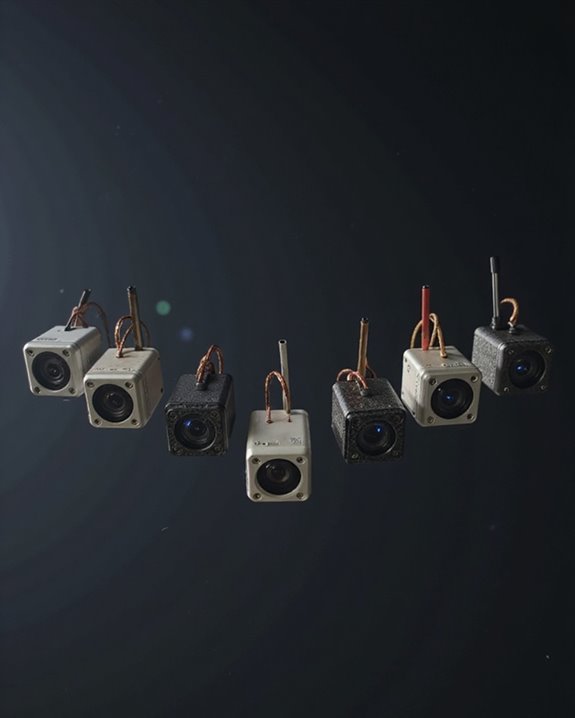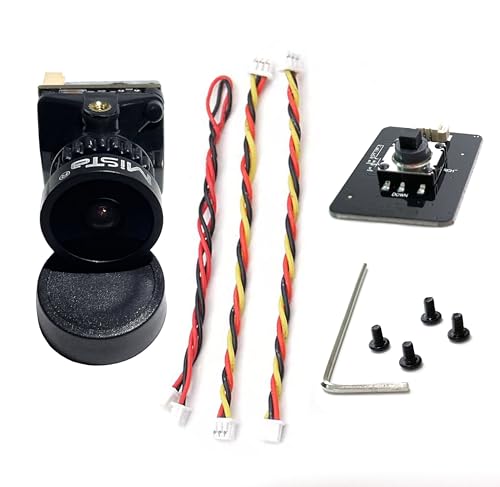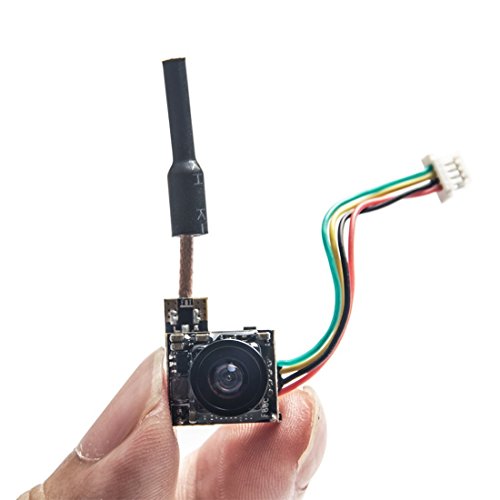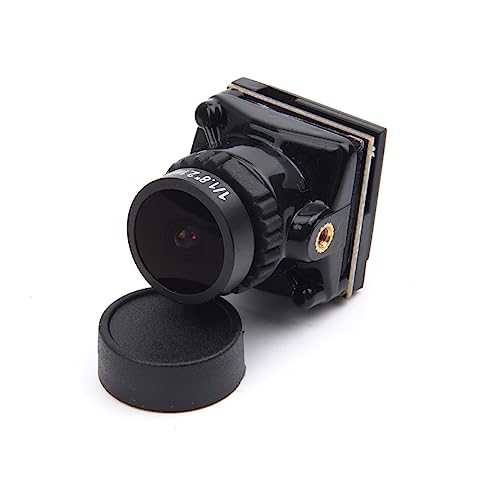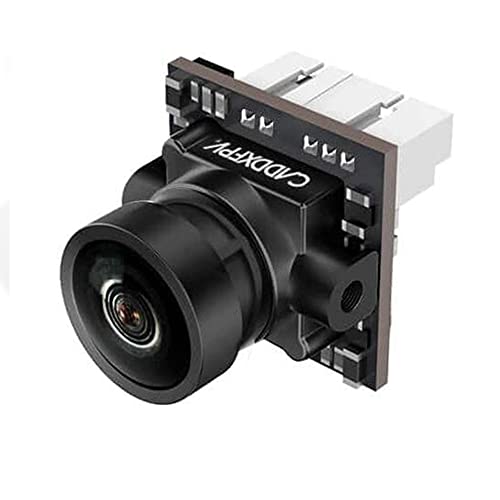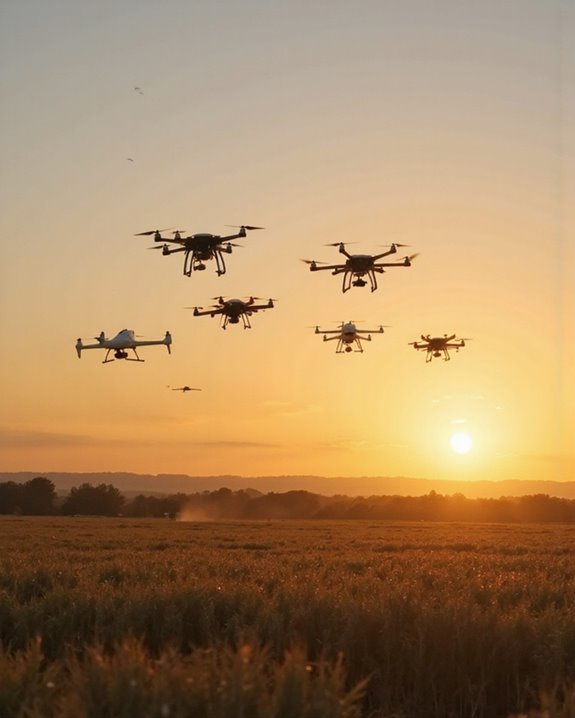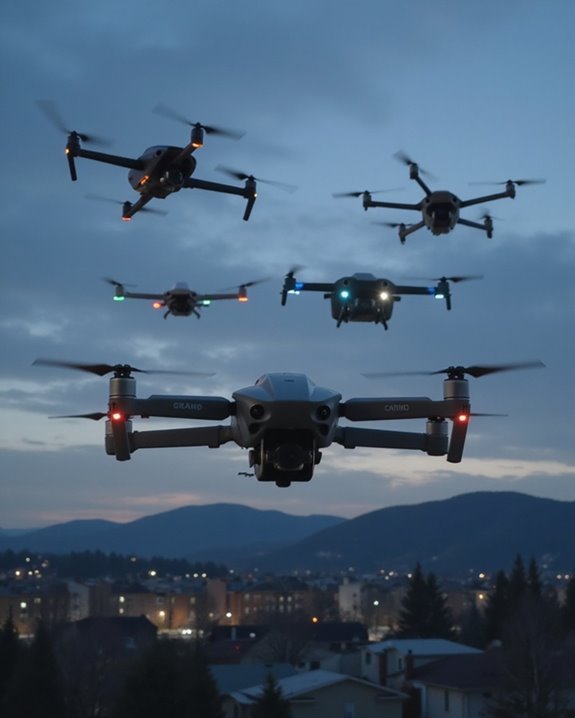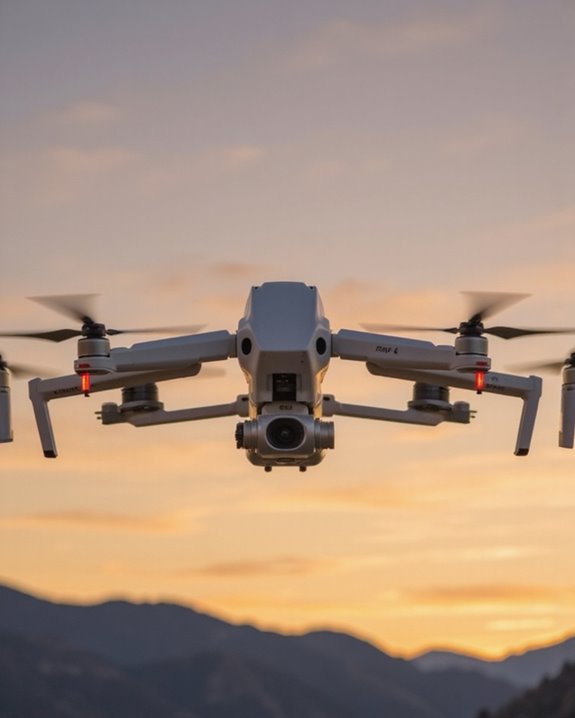Looking for the ultimate FPV camera for your drone? You’ve got some incredible options in 2025! The Readytosky 2000TVL and Foxeer Razer Mini lead the pack with their stellar resolutions and low-light performance. For racing enthusiasts, the ultra-lightweight RunCam Phoenix 2 SE and SoloGood Caddx Ant deliver exceptional clarity in compact packages. From the feature-packed WT07 Micro to the versatile 1800TVL Mini, today’s top cameras offer something for every pilot’s needs – let’s explore what makes each one special.
Key Takeaways
- The Readytosky 2000TVL FPV Mini leads the pack with its Starlight HDR sensor and exceptional night vision capabilities.
- The Foxeer Razer Mini offers excellent value with 1200TVL resolution and wide 4.5V-25V compatibility in a 12g package.
- RunCam Phoenix 2 SE delivers reliable 1000TVL performance with Global WDR and automatic day/night switching features.
- The 1800TVL FPV Mini Camera combines high resolution with versatile 5V-40V power compatibility and adjustable aspect ratios.
- SoloGood Caddx Ant stands out for ultra-lightweight builds at 2 grams while maintaining 1200TVL resolution.
Foxeer Razer Mini FPV Camera for Racing Drones
- 【High-Resolution Imaging】Equipped with a 1/3" CMOS sensor and 1200TVL resolution, the Foxeer FPV Camera Razer Mini delivers crystal-clear video output for superior...
- 【Wide Dynamic Range】Lower latency, 90db WDR, 0.01lux,it performs beyond your imagination under complicated conditions including sunny day, cloudy day, indoor, night...
- 【Widely Use】Supporting aspect ratios 4:3 and the ability to switch between NTSC and PAL formats cater to different user preferences and equipment compatibility,...
The Foxeer Razer Mini FPV camera stands out as a racing pilot’s dream, packing professional-grade features into an incredibly lightweight 12g package. You’ll love the crystal-clear 1200TVL resolution that helps you navigate tight turns with confidence, while the 150-degree diagonal field of view guarantees you won’t miss a thing!
The camera’s impressive 90db Wide Dynamic Range handles those tricky lighting changes like a champ, and with voltage input from 4.5V to 25V, you’re covered for practically any drone build. At just 22mm x 22mm, it’s so tiny you’ll forget it’s there – until you see those buttery-smooth video feeds that’ll make your competitors wonder what you’re running!
Best For: Racing drone pilots and FPV enthusiasts seeking a lightweight, high-performance camera with excellent low-latency video quality and wide viewing angle.
Pros:
- Extremely lightweight at just 12g and compact size (22x22mm) makes it ideal for racing builds
- Impressive 1200TVL resolution with 150° diagonal FOV provides excellent visibility for racing
- Wide 4.5V-25V input range makes it compatible with most drone setups
Cons:
- Higher price point compared to basic FPV cameras
- May require additional setup and configuration to optimize settings
- Limited mounting options due to its specific bracket requirements
Readytosky 2000TVL FPV Mini Camera for RC Drones
- Super Mini 2000TVL High Definition Camera high quality picture.
- 1 / 1.8 ''inch Starlight HDR Sensor, 2.1mm Lens, Design for separate OSD.
- Using M12 HD 5MP lens, High quality picture mirror function and Low Power Consumption and Low illumination.
Measuring just 0.74 inches on each side, Readytosky’s 2000TVL FPV Mini Camera packs impressive capabilities into an ultra-compact frame that’s perfect for drone pilots who don’t want to compromise on image quality or add excess weight.
You’ll love the camera’s versatility with its PAL/NTSC switchable modes and 4:3/16:9 aspect ratio options. The 1/1.8-inch Starlight HDR sensor delivers insane night performance, while the 2.1mm lens guarantees crystal-clear footage even in low light conditions. At just 1.13 ounces, it’s a featherweight champion that can take a beating – pilots report it’s survived numerous crashes! Plus, with its straightforward installation and mirror function, you’ll be capturing stunning aerial views in no time.
Best For: RC drone enthusiasts and FPV pilots seeking a lightweight, durable mini camera with excellent low-light performance and high-quality image capture capabilities.
Pros:
- Exceptional night vision performance with Starlight HDR sensor
- Ultra-compact and lightweight design at just 1.13 ounces
- Highly durable construction that survives crashes well
Cons:
- Requires additional spacers and long M2 screws for secure mounting
- Limited aspect ratio options (only 4:3 and 16:9)
- Analog camera technology may not match digital camera resolution quality
2000TVL FPV Mini Camera for Racing Drone
- Super Mini 2000TVL high definition camera provide high quality image
- 1/8' inch Starlight HDR Sensor, 2.1mm Lens
- Lower latency,Separate OSD,NTSC/PAL switchable
Racing enthusiasts seeking crystal-clear FPV vision will find their perfect match in this compact 2000TVL mini camera, which packs professional-grade features into an incredibly lightweight 0.48-ounce package.
You’ll love how this tiny powerhouse delivers ultra-low latency and HDR imaging through its 2.1mm lens, making every flight feel like you’re sitting in the cockpit! The camera’s minuscule 0.75-inch cube design won’t weigh down your racing drone, while the switchable NTSC/PAL formats and separate OSD give you complete control over your view. While its 3.4-star rating suggests there’s room for improvement, the sharp picture quality and straightforward setup make it a solid choice for pilots who want performance without breaking the bank.
Best For: Racing drone enthusiasts and FPV pilots who need a lightweight, compact camera delivering high-definition video with minimal latency.
Pros:
- Extremely lightweight at 0.48 ounces with tiny dimensions, making it ideal for racing drones
- Features HDR imaging and switchable NTSC/PAL formats for versatile performance
- Low power consumption and separate OSD for enhanced control and efficiency
Cons:
- Moderate 3.4-star rating suggests inconsistent user experiences
- Limited lens options with only 2.1mm available
- Made in China with potential quality control concerns
WT07 Micro 5.8GHz FPV Transmitter and Camera for Drones
- Power by 1S lipo battery
- 5.8GHz 5 bands 37 channels with Raceband: 5658-5917MHz
- All in one vtx + camera + antenna, plug and play, ready to fly
Designed specifically for ultra-compact racing drones, the WT07 Micro 5.8GHz FPV system packs impressive features into a tiny all-in-one package that’s even smaller than its WT05 predecessor!
You’ll love how this plug-and-play system simplifies your racing setup with its integrated 600TVL camera and direct OSD interface. Running on a 1S lipo battery, you’ve got access to 37 channels across 5 bands in the 5.8GHz range – plenty of frequencies to avoid interference during those intense race days! The button controls make switching channels a breeze, while the video in/out cable lets you connect straight to your OSD display. It’s the perfect choice when you’re building a compact speed demon!
Best For: Racing drone enthusiasts and FPV pilots looking for an ultra-compact, all-in-one camera and video transmission solution for their micro builds.
Pros:
- Compact all-in-one design integrates camera, VTX, and antenna in a single plug-and-play unit
- Wide frequency range with 37 channels across 5 bands helps avoid interference during races
- Simple button control interface makes channel switching quick and easy
Cons:
- Limited to 25mW transmission power which may restrict range
- Only compatible with 1S lipo batteries, limiting power options
- 600TVL camera resolution may not meet demands of pilots wanting higher image quality
1800TVL FPV Mini Camera with 2.1mm Lens for RC Racing Drones
- Super Mini 1800TVL High Definition Camera high quality picture, Upgraded 1500TVL,More clarity.
- Easier for installation, PAL/NTSCs with able suitable for more kinds of drones
- High quality picture mirror function and Low Power Consumption and Low illumination.
Serious FPV racers who’re looking for exceptional clarity will find their match in this impressive 1800TVL mini camera, a significant upgrade from standard 1500TVL models. You’ll love its super-compact 0.7-inch design that won’t weigh down your racing drone!
The 1/1.8-inch Starlight sensor delivers crystal-clear footage with an expansive 165° field of view, while the adjustable 4:3 and 16:9 aspect ratios let you customize your perspective. Don’t worry about power compatibility – this little powerhouse handles 5V-40V with ease. Made by YoungRC, it’s earning rave reviews from pilots who can’t stop raving about the image quality. Just remember, at only 1.13 ounces, this tiny camera packs a serious visual punch!
Best For: Perfect for competitive FPV drone racers who need high-quality, lightweight camera equipment with exceptional clarity and wide viewing angles.
Pros:
- Exceptional 1800TVL resolution with crystal-clear image quality
- Ultra-compact and lightweight design (0.7-inch cube, 1.13 ounces)
- Versatile power compatibility (5V-40V) and adjustable aspect ratios
Cons:
- Some mixed reviews about video quality consistency
- Limited customer review history (only 15 ratings)
- Basic 2.1mm lens with no option for interchangeable lenses
RunCam Spotter V2 FPV Camera and Transmitter Kit
- 【High-Performance FPV Camera】: The Spotter V2 Micro FPV AIO Camera is designed for fpv RC cars, RC boat,fpv drone,RC planes and other RC hobbies. With an integrated...
- 【Advanced FPV Video Transmitter】: Equipped with a 5.8G 40CH 20MW-200MW transmitter, this camera drone offers excellent signal strength for long-distance transmission....
- 【Integrated Mic & OSD】: Capture every sound with the integrated mic, perfect for an immersive FPV experience. The on-screen display (OSD) provides real-time data,...
The RunCam Spotter V2 FPV Camera and Transmitter Kit delivers a perfect balance of features for pilots who want to experience their flights through crystal-clear first-person view.
You’ll love the ultra-wide 170-degree field of view that captures everything in stunning 700TVL quality, making you feel like you’re right in the pilot’s seat! The adjustable 5.8G transmitter lets you dial in the perfect signal strength from 20MW to 200MW, so you’re always connected to your craft. With its built-in mic and OSD display, you’ll get real-time flight data and audio feedback that’ll make you feel like a pro. The compact design means you can mount it on practically any RC vehicle – from zippy drones to speedy cars!
Best For: RC enthusiasts and FPV pilots looking for a versatile, high-quality camera system that can be used across multiple types of remote-controlled vehicles while providing clear video feed and adjustable transmission power.
Pros:
- Wide 170-degree field of view provides excellent coverage and immersive flying experience
- Adjustable transmission power from 20MW to 200MW allows for flexible range options
- Compact and lightweight design makes it suitable for various RC vehicles and easy to install
Cons:
- 700TVL resolution may not satisfy users looking for HD quality footage
- 200MW maximum power might be insufficient for very long-range applications
- Built-in OSD features may be limited compared to more advanced FPV systems
KC02 FPV Transmitter with Sony CCD Camera (600mW)
- 600TVL perfect picture quality, specially designed for outdoor flying.
- Low Power Consumption and Low illumination, 1/3" SONY SUPER HAD II CCD,Nextchip 2040 DSP
- VTX 5V Out for Cam, Operating Voltage: 7-20 V Output Voltage(VOUT): 5 V,use 2S-4S battery,can not 6S battery
FPV enthusiasts seeking professional-grade video quality will find their match in AKK’s KC02 transmitter and Sony CCD camera combo! With its 600TVL picture quality and rugged SONY SUPER HAD II CCD sensor, you’ll capture crystal-clear footage even in challenging outdoor conditions.
You’ll love how versatile this system is – it works with 2S to 4S batteries and delivers reliable performance up to 1.5km with a clover antenna. The simple two-button display makes channel selection a breeze, while advanced camera settings let you fine-tune everything from white balance to exposure. Just watch out for the supplied power harness – you’ll want to rewire it properly to avoid any noise issues!
Best For: FPV drone pilots and RC enthusiasts seeking a professional-grade video transmission system with excellent picture quality and long-range capabilities.
Pros:
- High-quality 600TVL Sony CCD camera provides clear footage even in challenging outdoor conditions
- Versatile power compatibility (2S-4S batteries) and impressive 1.5km range with clover antenna
- User-friendly 2-button interface with LED display for easy channel selection
Cons:
- Supplied power harness needs rewiring to avoid noise issues
- Some units reported overheating and reset problems
- Camera can produce yellow shadows in bright light conditions
WT03 Micro FPV Camera with 5.8G Adjustable Transmitter
- Micro size, light weight
- Compatible with more types of RX
- Plug and play, ready to fly, perfect for DIY
Racing enthusiasts and budget-conscious pilots will love the lightweight WT03 Micro FPV camera, which packs impressive 600TVL resolution into a tiny 1.06-ounce package. You’ll get surprisingly good video quality and minimal breakup within 500 feet at 25mW power, making it perfect for indoor racing and outdoor flights around a football field.
Setup’s a breeze – just give yourself 2-3 minutes to mount it with zip-ties or tape. The adjustable power settings (25mW, 50mW, 200mW) and blue LED display let you dial in the perfect transmission strength for your flying style. At around $25, it’s quite the bargain, though you’ll want to be gentle with that bendable antenna!
Best For: Budget-conscious FPV racing enthusiasts and hobbyists looking for a lightweight, easy-to-setup camera system for indoor racing and short-range outdoor flights.
Pros:
- Excellent value at $25 with impressive 600TVL video quality
- Ultra-lightweight at just 1.06 ounces with quick 2-3 minute setup
- Adjustable power settings (25mW/50mW/200mW) for different range needs
Cons:
- Fragile antenna prone to bending and damage
- No voltage display or low battery warning system
- Gets hot when operating at maximum power settings
RunCam Phoenix 2 SE FPV Camera for RC Drones
- [Newest Analog FPV camera]: Real 1000TVL resolution, 1/2" CMOS sensor, FOV160°, Global WDR, Day/night Switch, allow you to freestyle flying at any time.
- [Durable Design]: Sandwich fully covered back cover design, Dust-proof and Short-circuit proof, effectively extend the life of the camera.
- [Unique Replaceable lens hood]: Anti-glare and lens protection camera comes with a lens hood, which not only protects the camera lens but also is anti-glare.
Modern FPV pilots seeking professional-grade performance will find their match in RunCam’s Phoenix 2 SE, a cutting-edge analog camera that packs incredible features into its micro-sized frame. You’ll love the crystal-clear 1000TVL resolution and wide 160° field of view that lets you see everything in your path!
At just 8.6g, this tiny powerhouse doesn’t mess around with its fully dust-proof design and replaceable lens hood. The built-in Global WDR and day/night switch guarantee you’re getting pristine footage whether you’re flying at high noon or sunset. Plus, with both 4:3 and 16:9 aspect ratios available, you can customize your view exactly how you want it. Talk about flexibility in a mighty mini package!
Best For: FPV drone pilots and RC enthusiasts who need a high-quality, lightweight camera for capturing clear footage in various lighting conditions.
Pros:
- Exceptional 1000TVL resolution with wide 160° field of view for comprehensive coverage
- Lightweight (8.6g) and durable design with dust-proof protection and replaceable lens hood
- Versatile performance with Global WDR and day/night switch for consistent image quality
Cons:
- Some users report issues with artifacts in the footage
- Pinout discrepancies may cause connection difficulties
- Relatively higher price point compared to basic FPV cameras
SoloGood Caddx Ant FPV Camera 1200TVL for RC Drones
- New generation of nano FPV camera with upgrade newest imaging tech
- Ultra Light Weight: Only weighs 2g for extream FPV racing drone exprience
- High Standard Image Specs: Equiped 1/3" CMOS sensor and 1200TVL 1.8mm lens
Weighing in at just 2 grams, the SoloGood Caddx Ant FPV Camera is a mighty miniature marvel that’s perfect for pilots who need ultra-lightweight performance in their micro builds.
You’ll be amazed by its 1200TVL resolution and 1.8mm lens that delivers crystal-clear 16:9 footage, even in challenging lighting conditions. The camera’s Global WDR and 3D DNR technology guarantee you’ll capture smooth, detailed video whether you’re zipping through shadows or bright sunlight. At just 14x14mm (19x19mm with bracket), this tiny powerhouse fits perfectly on your favorite cinewhoop or tinywhoop build. Plus, with easy plug-and-play installation and PAL/NTSC switching, you’ll be up and flying in no time!
Best For: FPV drone enthusiasts and micro-drone builders seeking an ultra-lightweight, high-quality camera for their tiny builds and cinewhoops.
Pros:
- Extremely lightweight at just 2g, making it ideal for micro builds
- Excellent 1200TVL resolution with wide dynamic range for clear footage in varied lighting
- Compact size (14x14mm) with versatile mounting options and easy installation
Cons:
- Limited lens options (fixed 1.8mm only)
- May require additional protection due to minimal housing
- Higher price point compared to basic FPV cameras
Factors to Consider When Choosing an FPV Camera
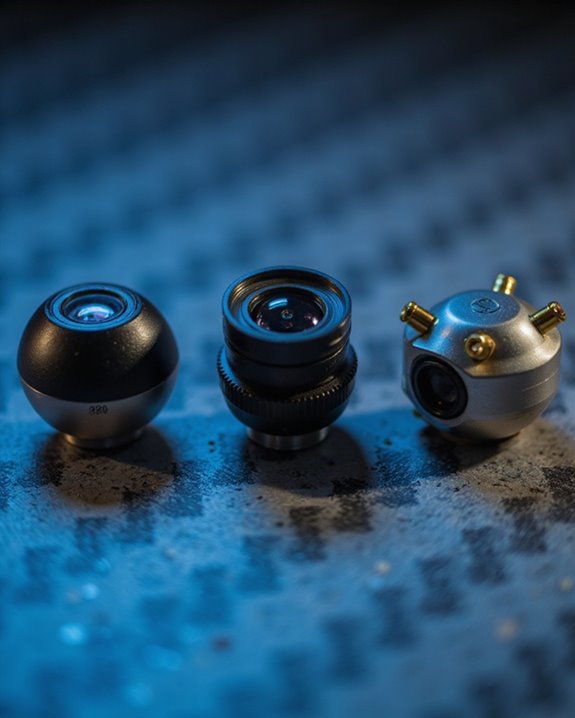
When building your perfect FPV setup, you’ll need to match your camera’s specs to your flying style and drone’s capabilities. Your key considerations should include resolution and image quality for crystal-clear views, size and weight limitations of your frame, power requirements that work with your system, low-light performance for those sunset flights, and the perfect field of view for your racing or freestyle needs. Think of choosing an FPV camera like picking the right pair of eyes for your drone – they’ve got to handle everything from bright sunny days to those tricky twilight sessions!
Resolution and Image Quality
The resolution and image quality of your FPV camera can make the difference between a crisp, immersive flight experience and feeling like you’re piloting through a foggy windshield! You’ll want to aim for higher TVL ratings – up to 2000TVL will give you razor-sharp details that’ll make you feel like you’re actually sitting in the cockpit.
Look for cameras featuring advanced CMOS or starlight sensors, which are absolute game-changers in varying light conditions. A solid WDR capability of around 90dB will keep your view balanced and clear, even when you’re zipping between bright skies and shadowy spaces. Don’t forget about latency – you’ll need those crystal-clear images delivered instantly to your goggles! And for those sunset flights, a minimum illumination rating of 0.001Lux will guarantee you’re not flying blind when the light gets low.
Size and Weight Specs
Size and weight specs can make or break your FPV drone setup – trust me, every gram counts! You’ll want to focus on cameras that measure between 14mm to 22mm square, giving you plenty of mounting flexibility without compromising your build. Think of it as finding the perfect lightweight dance partner for your drone!
When it comes to weight, you’re looking at options ranging from featherlight 2-gram models to slightly beefier 12-gram units. For most pilots, staying under 10 grams is ideal, as it’ll help maximize your flight time and keep your drone nimble in the air. Pay close attention to those three-dimensional measurements (length, width, height) too – they’ll typically fall between 0.39 to 0.75 inches, ensuring you can mount your camera exactly where you need it!
Power Supply Requirements
Beyond physical dimensions, understanding your FPV camera’s power needs will keep you flying smoothly without any mid-air surprises! You’ll want to guarantee your camera’s voltage requirements match your drone’s power system – typically anywhere from 4.5V to 40V depending on the model.
Most modern FPV cameras are power-efficient little beasts, drawing just a few milliwatts to keep your battery happy for longer flights. When selecting your camera, check its compatibility with your preferred LiPo setup (1S to 4S), and don’t forget about voltage regulation! Nothing ruins your aerial footage faster than power fluctuations causing a fuzzy feed or sudden blackout. Many newer cameras come with built-in protection against power mishaps, but it’s still vital to match your camera’s specs with your drone’s electrical system. Your future self will thank you!
Low Light Performance
Night-flying enthusiasts know that stellar low-light performance can make or break your FPV experience! You’ll want to keep an eye on those minimum illumination ratings – the lower the lux number, the better your camera will perform when the sun goes down. Think 0.001 lux or less for those twilight racing sessions!
Modern FPV cameras pack some serious tech to help you navigate the darkness. HDR sensors capture both shadowy corners and bright spots, while 3D noise reduction keeps your footage crisp instead of grainy. Don’t forget about auto gain control, your digital co-pilot that adjusts sensitivity on the fly! And with flexible shutter speeds ranging from 1/25 to 1/10000 seconds, you’ll nail those quick maneuvers even when lighting isn’t perfect. After all, the best pilots don’t let a little darkness ground their drones!
Field of View Range
While mastering low-light performance puts you ahead of the game, selecting the right field of view (FOV) can make you feel like you’ve got superhuman vision! Your choice will dramatically impact how much of the world you’ll see through your drone’s eyes.
If you’re racing through tight spaces or performing technical maneuvers, you’ll want to choose a narrower 125° FOV for that crisp, distortion-free center view. But for those epic freestyle flights where situational awareness is key, go wide with 150-170° – you’ll thank yourself when threading that needle between trees! Most pilots find their sweet spot around 150° diagonal FOV, which gives you that perfect balance of peripheral vision and image clarity. Remember, wider isn’t always better – it’s about matching your FOV to your flying style!
Frequently Asked Questions
How Long Does the Average FPV Camera Battery Last During Flight?
You’ll typically get 20-45 minutes of flight time from your FPV camera battery, but it really depends on your setup! Most modern cameras draw between 100-200mA, which won’t drain your drone’s main battery too quickly. If you’re using a separate camera battery, you’ll get even longer recording times. Just remember to keep an eye on your voltage levels – nothing worse than losing that epic footage mid-flight!
Can FPV Cameras Work in Extreme Weather Conditions Like Rain or Snow?
Just like your trusty old Nokia 3310, modern FPV cameras are pretty tough cookies! You’ll find that most high-quality FPV cameras can handle light rain and snow, but you’ll want to make sure they’re properly protected. Many cameras come with an IPX4 or IPX5 rating, meaning they’re splash-resistant. However, you shouldn’t push your luck in heavy downpours. For the best protection, you can add a protective housing or conformal coating to your camera.
What’s the Typical Lifespan of an FPV Camera Before Needing Replacement?
You’ll typically get 1-2 years of solid performance from your FPV camera with regular use, though this can vary based on how you treat it! With proper care and maintenance, some pilots have stretched their camera’s life to 3+ years. Factors like crash impacts, operating temperatures, and moisture exposure play a huge role in longevity. Here’s a pro tip: keep your lens clean and protected, and your camera will thank you with extended service life.
Are FPV Cameras Compatible With Both Analog and Digital Drone Systems?
Just like how you can’t play your vinyl records on a CD player, FPV cameras aren’t universally compatible between analog and digital systems. You’ll need to match your camera type to your drone’s video transmission system. Most cameras are specifically designed for either analog or digital setups – analog cameras work with traditional 5.8GHz systems, while digital cameras pair with systems like DJI’s HD transmission. However, some modern hybrid cameras can now handle both!
Do I Need Special Licenses or Permits for Using FPV Cameras?
You don’t need special permits just for FPV cameras themselves, but you’ll need proper drone licensing depending on how you’re using them. If you’re flying commercially, you’ll need your Part 107 certification from the FAA. For recreational flying, you’ll just need to register your drone and follow basic TRUST certification requirements. The camera’s only along for the ride – it’s the drone that needs the paperwork! Just keep those flight rules in mind.

